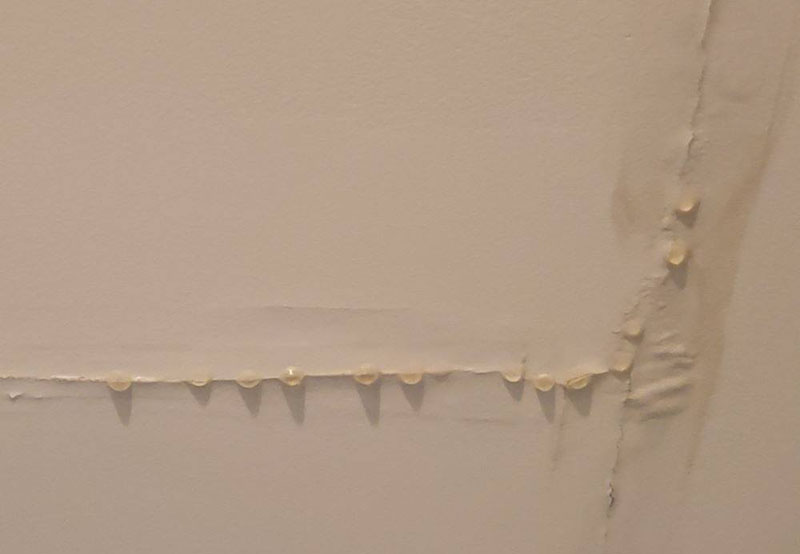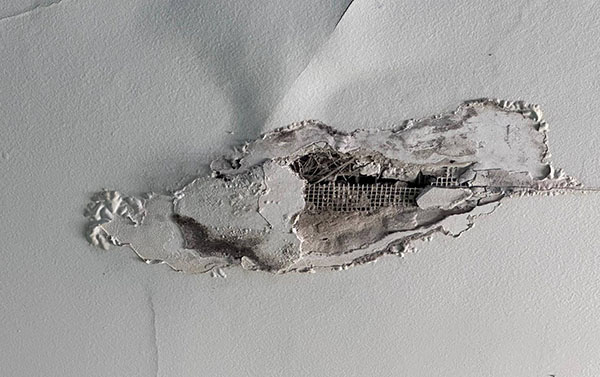Yes, a leaking ceiling can lead to a collapse, as leaking can weaken and damage the structure, and eventually, the ceiling will become unstable and collapse. One of my friends had roof damage during a storm and clogged gutters, ultimately leading to water leaking from the ceiling.
Even one of my neighbor’s ceilings collapsed because they didn’t think it could become a severe issue and left it like that. Don’t worry! I will discuss all the possible causes, how to identify them, what to do in these situations, and how to prevent collapsing or further damage. Let’s get into it!
Quick Jump
What are the Causes of Leaking Ceilings? [5 Reasons]

There could be single or multiple reasons behind the causes of leaking ceilings, such as plumbing issues, roof damage, clogged gutters, condensation, and structural damage or crack.
Any of these could happen why that might be happening, and I will go through them individually in detail.
Reason #1: Plumbing issues are among the most common and significant causes of leaking ceilings. There might be cracks or gaps in the pipes, or the problem can arise when the lines are old and deteriorating. In that case, the issue could lie in the areas like bathrooms, kitchens, or laundry rooms, which can cause water to drip onto the ceiling below and cause damage.
Reason #2: The second one is roof damage, another common issue people face. Over time, roofs can become damaged due to harsh weather conditions, such as hail, heavy rain, or strong winds, and due to that, the roof can have missing shingles, allowing water to seep through and into the building, causing leaks in the ceiling below.
Reason #3: The third one I will talk about is clogged gutters, which can lead to a whole host of problems, and one of the most serious of these is a leaking ceiling. When you don’t clean your roof regularly, your gutters get clogged with leaves, dirt, and other debris.
As a result, Instead of diverting water away from your home as they’re meant to, it can become filled with standing water, which can overflow onto the roof during heavy rain or storms. And, eventually, causing water damage and potentially leading to a leak.
Reason #4: The fourth one, condensation, is one of the sneaky culprits that can lead to a leaking ceiling. It occurs when warm, moist air from within the building rises and comes into contact with a cooler surface, such as the ceiling. And when that happens, water droplets accumulate over time, eventually leading to water damage and ceiling leaks.
Reason #5: Lastly, any structural damage within the building could allow water to leak through and damage the ceiling. It can happen if there is an issue during construction, poor material, or seismic activity. Besides, leaving it like that can worsen over time and cause even more severe problems, such as collapsed ceilings or walls.
What Does a Water Leak on a Ceiling Look Like?
There will be stains, dripping water, sagging, damp spots, or peeling paint, and you will know a water leak on a ceiling when you see something of these things. But, to make sure, here is detailed information about a water leak and what the top will look like.
- When the leak starts on your ceiling, you will see small damp spots or puddles. That’s how you know the leak is recent, and it’s high time to fix it now.
- You might notice water stains, which may appear as discolored patches, brown rings, or streaks. It is the most common and noticeable sign of all.
- Yes, peeling wall paint can happen for many reasons, and water leaking in the ceiling is one of the most common. Because when water seeps through the roof, you will notice the peel or bubble.
- When there is heavy rain, and the water doesn’t pass properly, or maybe there is a leak or crack in the roof, the water stays there, and the weight of the water can cause the ceiling to sag or bulge. And because of that, you will notice a dip in the ceiling or a bulge that wasn’t there before.
- When water is there for a long time, or the wall and ceiling get damp, you will also notice a musty odor. It’s because there might be mold growth issues, and it is causing that.
These are the clear and common signs of how you will know if there is a leak from the ceiling.
When Can a Leaking Ceiling Lead to Collapse?

Nobody wants their ceiling to collapse above their or family members and cause severe harm. That’s why it’s better to know when to take this matter seriously before anything happens.
Of course, the first time you notice any of the signs I mentioned above, you should start repairing or replacing them or take any necessary measurements. Besides, If a leaking ceiling is left unchecked, the water can seep into the ceiling structure and weaken the materials over time.
As mentioned, When water accumulates in a ceiling, it creates a damp environment ideal for mold and mildew growth. You and I both know what that does. And by any chance, if you ever leave heavy equipment or objects on the ceiling, a leaking ceiling can become a major hazard.
No matter what, you must promptly address any signs of a leaking ceiling to prevent further damage and ensure the safety of those in the building. Besides, if you’re confused about what to do, don’t hesitate to ask for professional help.
Although I will go through a few things you must do when you find out there is leaking in your ceiling.
What to Do When You Have a Leaking Ceiling? Follow These!
It can be overwhelming and frustrating when you don’t know how to solve this situation. I have been in that position, so I understand your feelings.
That’s why I have gathered all the necessary information, and I will discuss it step by step to help you understand.
Step #1: The moment you see a leaking in your ceiling, your first step is to turn off the power source without any delay, as water can come into contact with electrical wiring or devices.
Step #2: After that, you will need to carefully find the exact area where the leaking is happening and why it is happening. As I discussed all the possible causes, it might help you find the reason. If it is difficult to understand the situation, it’s better to call a professional.
Step #3: From this part, you will try to fix the issue with small steps. And the first step would be to stop the source of the water. The source could be the roof creak or any pipe issue. Whatever the issue might be, you must stop the water any further.
Remove standing water or damp materials, such as furniture or carpets, to prevent further damage and mold growth. If the problem is too complex or needs more hands, don’t hesitate to ask your friend or any professional help.
Step #4: When that’s done, inspect for the damages it has done to your ceiling. It’s a good idea to take videos and photos just in case you have any insurance for your house.
Step #5: You must repair the leak that started all these. But before that, you must dry the area properly so there is no issue when repairing that part. You can use fans or dehumidifiers to dry out the affected area.
Step #6: After drying the area, start fixing the leak. If the leak or issue is simple enough, you won’t have that much trouble. The probable cases could be fixing a plumbing issue, repairing a damaged roof, or addressing any structural damage.
Step #7: Even though the problem is gone, you still need to check now and then if that’s going to be back. So, it’s better to Monitor the affected area to ensure the leak has been properly repaired.
These are more or less the step you might need to follow. In that case, if it is too complex to fix the issue, ask for a professional so that you won’t have to face the problem any further.
Steps To Prevent Future Leaks From Ceilings

If the problem lies in your building structure, it will be costly to repair, and you will need expert help to fix that because these are complex cases to deal with.
But, besides that, you can take some preventive measures so that you won’t have to face the issues again.
- It’s the eldest and most common issue to fix or avoid any problem. Regularly inspect your roof, gutters, and plumbing systems to ensure they are in good condition, and that’s it.
- Roof issues start with a gutter or heavy rain, missing or broken underlayment, etc. So, keep your gutters and downspouts clear of debris to ensure proper water drainage.
- As mentioned before, air leaks and condensation can lead to moisture issues, so ensure everything is sealed and insulated.
- Another prevention method for roof damage is trimming trees or branches that may be touching or rubbing against your roof.
- Water alarms are another way to preserve the damage as it is so that it doesn’t go any further.
Wrap Up
Leaking the ceiling can significantly harm you or your family, not to mention how much money it will cost you to repair and other issues. That’s why it’s better to find the cause as soon as possible to repair the leaks.
Besides, I also discuss how you will know when and how to see the leaks and how to prevent the issue. Let me know if there are any other things you were looking for or any other queries, so I can get back to you and answer that.
Until then, good luck!

Roger Lewis is an experienced roof repair contractor with over 15 years of industry experience. He is known for his expertise in all aspects of roof repair, including leak detection, shingle replacement, and gutter repair.
